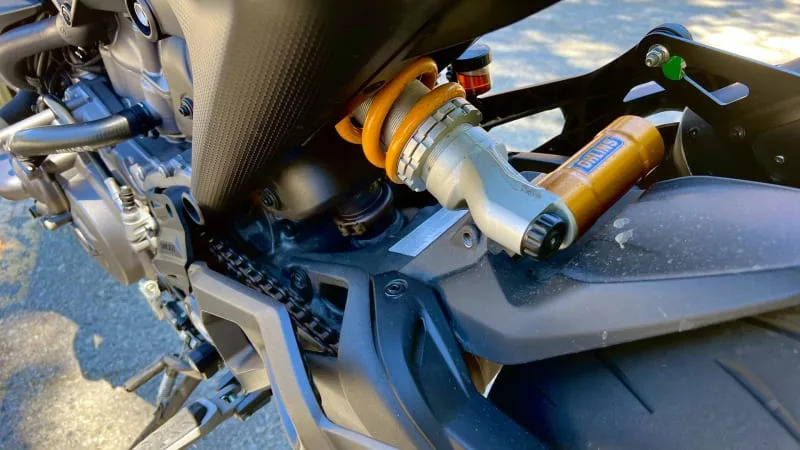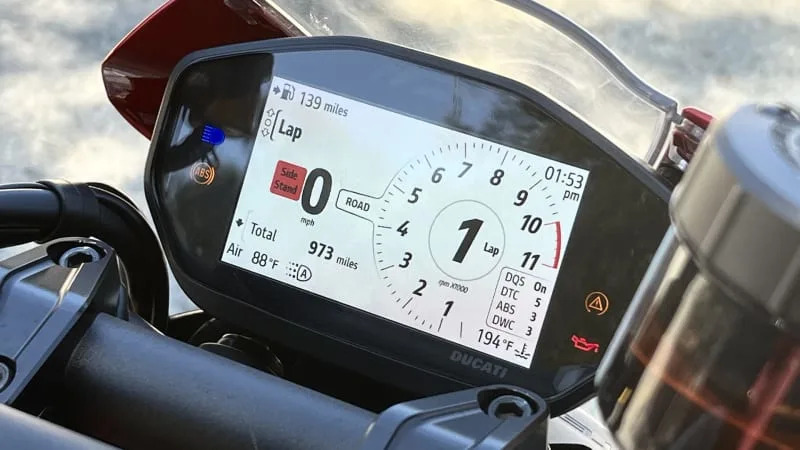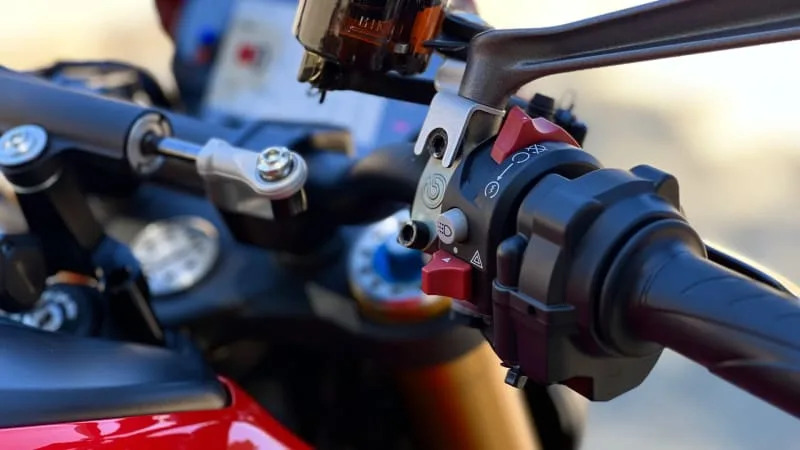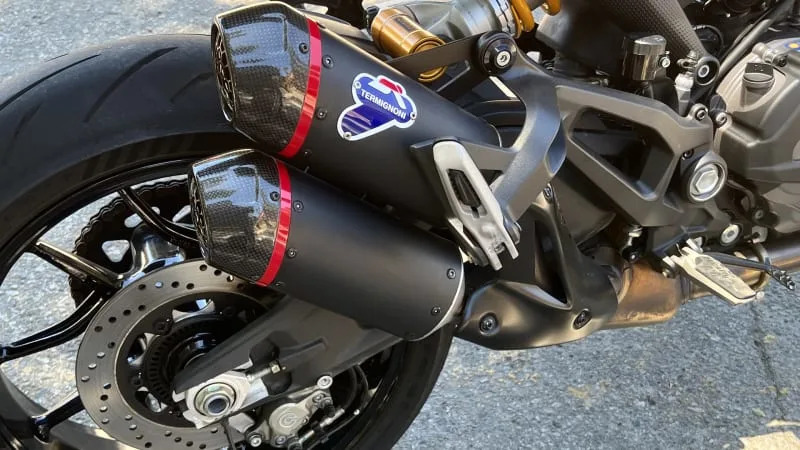In 1993 Ducati took a gamble on a new class of motorcycles. Dubbed naked bikes, they take sportbike engineering and strip it of most of the bodywork, exposing its mechanical glory for all to see. Ducati called it the Monster and similar to how the Cayenne saved Porsche, Ducati’s gamble paid off.
Now 30 years later, the Monster is alive and well with a full redesign that took place for the 2021 model year. This new generation has all of the muscular heft of its predecessors, but sadly its iconic trellis frame has been eliminated in favor of a more anonymous cast alloy subframe that blends in with the engine.
That engine is a 937-cc 90-degree V-twin that’s good for 111 horsepower and 69 pound-feet of torque. While those figures aren’t so impressive when compared to passenger cars, consider this Monster SP’s curb weight of 410 pounds with a full tank. That equates to a weight-to-power ratio of 3.7:1. That’s better than a Porsche 918 or Pagani Huayra, yet the bike has an MSRP of only $15,695, which is less than a Nissan Versa. Bang for the buck, indeed.
This Monster SP is a step up from the entry-level Monster Plus, featuring Öhlins dampers, lighter Brembo brakes, a lightweight lithium-ion battery, a steering damper, sticky Diablo Rosso IV tires and a Termignoni carbon fiber exhaust. These upgrades increase the SP’s cost by $2,700 over the Monster Plus.
Swinging a leg over the Monster SP, my 32-inch-inseam legs are long enough to have both feet on the ground, though my heels only touch if I stand straight up. It’s a solid enough stance that I wouldn’t bother getting the lower seat accessory that drops riders by 1.2 inches. The entry-level Monster Plus rides almost an inch lower due to it lacking the Öhlins damper upgrade, and can even be had with a suspension that lowers the ride height by yet another inch. So, it’ll be worse, but smaller people will be more likely to fit on it.
The wide dirtbike-like bars are a departure from the narrow handles found on sportbikes and their placement higher and further aft means you sit more upright. The footpegs are also lower and pushed forward to provide a more comfortable riding position than a typical sportbike.
With a downward flick of the thumb on the ignition switch, the Monster’s V-twin groggily turns over. The weak startup made me think that perhaps the battery was low, but it started every time with a mechanical clatter and underlying baritone from the twin exhaust pipes. The idle is rough and lumpy, with a rather noisy rattle that sounds more like a portable air compressor than a motorcycle. That may seem critical, but for seasoned riders, that clatter is a portent of good things to come in the same way an over-cammed small-block Chevy does.
Rolling down the boulevard on my way to the coast, the Monster is well-mannered and stable. The clutch lever has an appropriate amount of effort and with a stomp of the left foot, the transmission clunks into first gear. Clutch engagement is easy, with a wide friction zone to ease the bike forward smoothly. The new Monsters come with Ducati’s Quick Shift system that eliminates the need to pull the clutch in with each shift after the initial first gear engagement. You just lift your foot to pop the shifter into the next gear. That’s nothing new for experienced riders who often feather the throttle for an instant to unload the gear cogs before kicking into the next gear. It’s somewhat similar to rev-matching in cars, making operation easier for novices.
Weaving between cars (still legal in California), the Monster’s wide bars keep you from splitting through narrower gaps, but most drivers in L.A. are considerate enough to give you room if they see you coming. The throttle is very manageable with an approachable amount of power that won’t try to buck you off if you’re careless. When you want power, it’s there in an instant with torque that won’t scare you.
Once on Pacific Coast Highway, I’m struck by how leisurely the Monster can be. The more relaxed riding position allows me to soak in more of the scenery as the thick, cool and briny air pushes gently against my torso. Past the beach, I even get a whiff of suntan lotion through the helmet. On the lazy curves, the bike can be leaned in with just a slight shift of the shoulders, and tying several sequences of bends together results in a graceful dance of rider and machine. It’s as intuitive and engaging as snowboarding down an intermediate run under perfect snow conditions. A deep cleansing breath and all is right in the world.
Once comfortable on the Monster, it’s time to dig deeper into performance. Turning onto one of the many circuitous secondary roads, the bike’s lightness and balance are readily apparent. It’s not as top-heavy as some other bikes, making it delightfully agile and playful. This is especially true in tight hairpin turns that often make sportbikes feel clumsy.
It’s easy to trail the front brakes all the way down to an apex with only slight pressure from two fingers. The riding position allows you to adopt more of a racing tuck, keeping your center of gravity low as you point your knee and chin into the turn, but as nimble as the bike is, it seems like overkill to ride it like Francesco Bagnaia. Instead, I opted to just shift one butt cheek off the seat and tipped the bike in with my shoulders.
A couple of quick half-clutched downshifts and I’m at the apex. Back on the power and the Monster eagerly slings me out the other side, gaining speed and fury until I rinse and repeat. This is the magic of the Monster SP, and indeed almost any well-conceived motorcycle. There’s no need to be timid on the throttle, either, as wheelie control will keep the front tire from shooting skyward. Traction control adds some assurance against silt on the edge of the road, too.
There’s also a “save-your-butt” feature in Cornering ABS. If you’re heading into a turn too hot, this system allows you to get on the brakes mid-turn without the catastrophic results you’d normally experience. It uses accelerometers to determine your lean angle and the computer applies the right amount of braking to keep you on your intended path. Thankfully, I never had to test this out.
On longer straightaways where you can run the engine into the higher revs, the Monster’s personality changes. With an aggressive twist of the wrist, the bike lurches forward with determination. I tuck down to put my chest on the tank to streamline my silhouette and the engine clatter gives way to an inspiring tenor tone that would make Pavarotti blush. Everything seems to smooth out with a zen-like trance in a storm, except for the wind. Buffeting really doesn’t become that noticeable until you exceed 80 mph or so and the Monster doesn’t make you feel as exposed to the wind as its fairing-free style suggests.
After about two hours in the saddle, my backside began to feel some hard points. In the Monster’s defense, I do have an unusually bony butt. There’s plenty of room to reposition yourself to get some rotating relief, though. Back onto PCH and I give myself another deep cleansing breath as I can relax again.
This kind of versatility between sport and cruising makes the Monster such a desirable choice. It’s easy to ride conservatively and with ample room from the seating position, you can enjoy it longer than you would on a sportbike. It’s not as reactive as a sportbike, but it’s also not as punishing or cramped. It’s thoroughly entertaining and thrilling to ride hard, but it’s not terrifying. In many ways, the Monster SP is as approachable as a Mazda Miata until you really get into the power. Then it morphs more into a Mustang GT.
Performance-minded riders will likely find the limits very quickly, but like a Miata or Mustang, there’s a lot of inspiration at that limit. Unfortunately, the current Monster lineup starts and ends with this 937-cc model as the 147-hp Monster 1200 line was discontinued in 2021 and the company no longer makes smaller displacement feeder variants. Of course more adventurous shoppers have the more powerful Streetfighter with a bit more bodywork, along with Ducati’s full-fairing sportbikes to graduate up to.
Altogether, the Ducati Monster is an excellent intermediate motorcycle. It has the power and handling to get your blood pumping, but it’s not overly energetic to intimidate you. With muscular styling, it’s also one of those bikes that will get you to turn around for one last look before you walk away. While the current Monster may have lost its characteristic trellis frame, its unique spirit remains intact.










